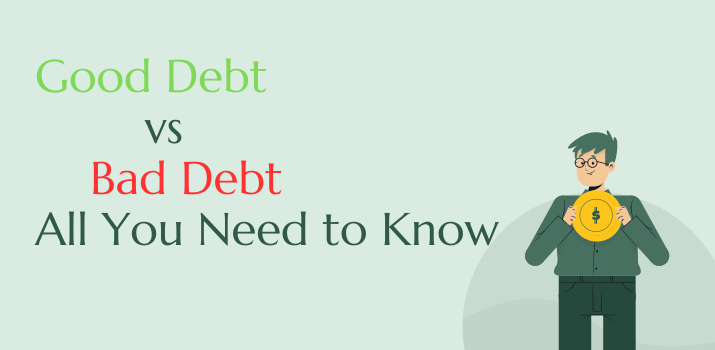Good Debt vs Bad Debt - All You Need to Know

Differentiating between good debt and bad debt can help you make better financial decisions. Here’s a breakdown of the characteristics and examples of each type:
Good Debt
This type of debt is basically an investment that will grow over long-period of time. It is often considered a strategic move to improve your financial situation over time.
1. Purpose and Potential Returns:
- Education Loans: Borrowing to pay for education can be considered good debt because it can lead to higher earning potential and better job opportunities in the future.
-
Mortgage Loans: Taking a mortgage to buy a home can be good debt, as property often appreciates in value over time. Additionally, owning a home can save you money on rent and provide stability.
-
Business Loans: Borrowing to start or expand a business can be good debt if the business becomes profitable. This can increase your income and build wealth over time.
-
Real Estate Investments: Loans taken to invest in real estate, such as rental properties, can generate rental income and appreciate in value.
2. Interest Rates:
- Generally, good debt comes with lower interest rates.
-
Mortgages and student loans often have more favorable terms compared to other types of debt.
3. Tax Benefits:
- Mortgage interest and student loan interest can sometimes be tax-deductible, reducing the effective cost of the debt.
4. Long-term return:
- Good debt typically finances assets that appreciate over time or generate income, contributing positively to your net worth.
Bad Debt
Bad debt typically involves borrowing for items that do not increase in value or generate income. This type of debt can lead to financial strain and may hinder your financial goals.
1. Purpose and Consumption:
- Credit Card Debt: Using credit cards for everyday expenses or luxury items and carrying a balance month-to-month usually results in high-interest charges, making this debt difficult to pay off.
-
Auto Loans: While necessary for many people, cars depreciate quickly. Borrowing a large amount for a vehicle that loses value over time can be considered bad debt.
-
Personal Loans for Non-Essentials: Borrowing for vacations, expensive gadgets, or other non-essential items can be bad debt, as these do not provide a return on investment.
2. High-Interest Rates:
- Bad debt usually carries high-interest rates, increasing the cost of the borrowed money.
-
Credit card debt is a common example, with interest rates that can be significantly higher than other types of debt.
3. Lack of Returns:
- Bad debt finances items that depreciate in value quickly, such as electronics, cars, and vacations.
-
It does not contribute to your long-term financial growth and can drain your resources.
Key Differentiators
1. Value Appreciation: Good debt is usually associated with assets or investments that appreciate over time (e.g., education, real estate). Bad debt is tied to items that depreciate (e.g., cars, electronics).
2. Income Generation: Good debt often generates income or improves earning potential (e.g., business loans, education). Bad debt typically does not generate income and might lead to increased financial burden.
3. Interest Rates: Good debt often comes with lower interest rates and more favorable terms. Bad debt, especially credit card debt, often has higher interest rates, making it more expensive to carry.
4. Purpose: Good debt is typically taken on with a clear plan for repayment and a strategic purpose. Bad debt is often incurred for immediate gratification without long-term benefits.
Tips for Managing Debt
1. Prioritize Paying Off Bad Debt: Focus on paying off high-interest, non-essential debt first.
2. Budget Wisely: Create a budget to manage your finances and avoid accumulating bad debt. You can use MoneyTrek to effectively track the income/expenses and see the upcoming month expenses.
3. Use Debt Strategically: Borrow only when it can improve your financial situation and you have a clear plan for repayment.
4. Monitor Interest Rates: Be aware of the interest rates on your debts and look for opportunities to refinance or consolidate to lower rates.
By understanding the difference between good and bad debt, you can make more informed decisions that support your long-term financial health.